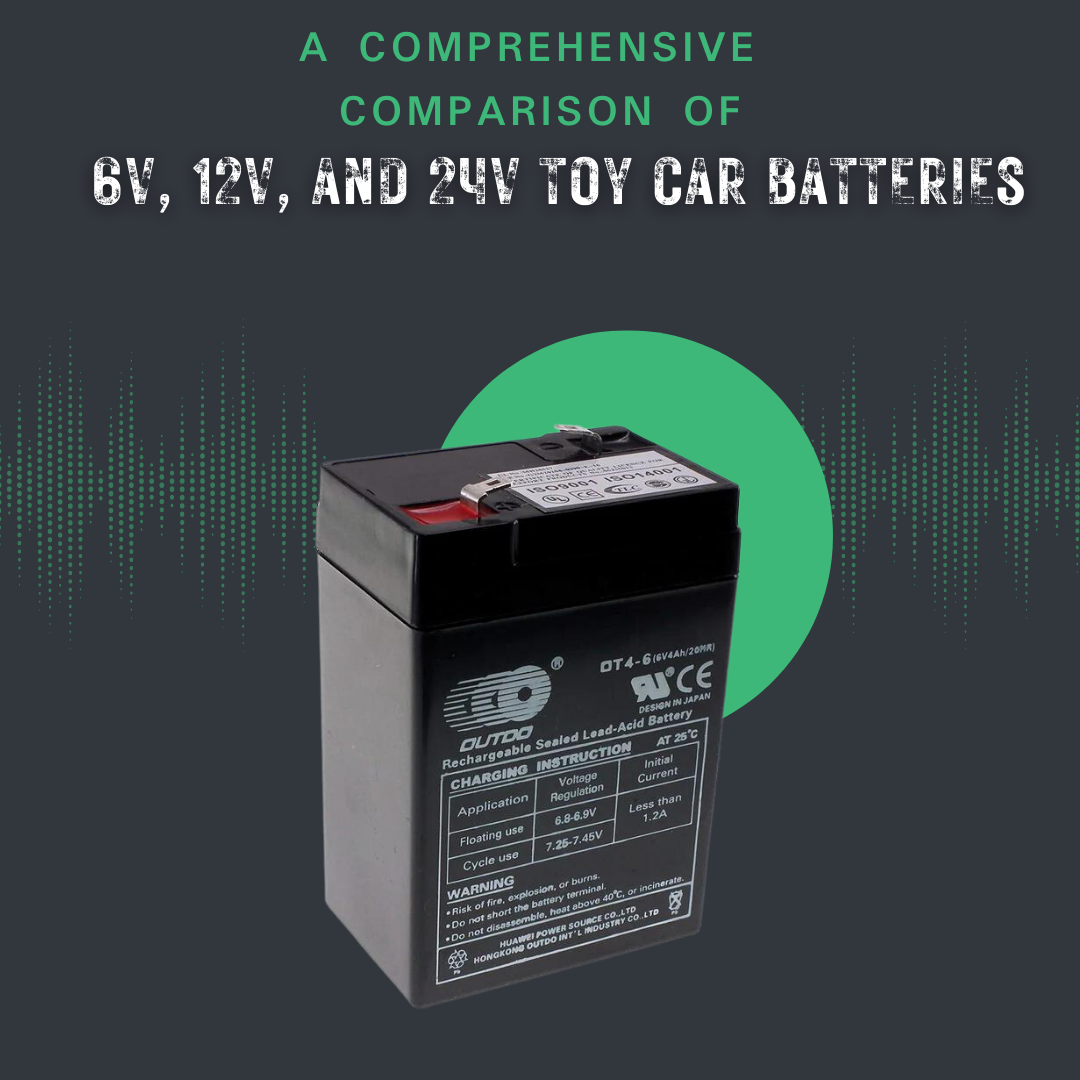Updated: 16.05.25
Choosing the right battery for your child’s ride-on car can feel overwhelming with so many options. You want a fun, safe experience tailored to their age and skill level. This guide simplifies the choice between 6V, 12V, and 24V batteries, detailing their features, performance, and suitability to ensure hours of joyful, secure playtime.

1. Understanding Toy Car Batteries
The Role of Voltage
Voltage (V) measures electric potential, determining the power behind your child’s ride-on car. Higher voltage means more speed and capability, impacting the driving experience.
Voltage and Speed
Voltage drives the motor, directly affecting speed. Higher voltage batteries propel cars faster, but the right choice depends on your child’s needs. Explore how batteries are made in our battery production guide.
2. 6V Batteries
Suitability and Performance
6V batteries are ideal for toddlers aged 2–4, powering ride-on cars at 2–3 mph. This gentle speed ensures safety while fostering motor skills and confidence for young drivers.
Pros and Cons
- Pros: Safe for toddlers, low speed reduces accident risk, builds confidence.
- Cons: Less exciting for older kids, limited to smooth surfaces, struggles on rough terrain.
3. 12V Batteries
Suitability and Performance
12V batteries suit kids aged 2–8, offering 3–5 mph speeds and supporting more weight. They power single- or double-seater cars with features like headlights or MP3 players, balancing fun and affordability. Learn more in our 12V battery lifespan guide.
Pros and Cons
- Pros: Versatile for a wide age range, supports more weight and features, higher speeds.
- Cons: Requires frequent charging, higher speeds need closer supervision.
4. 24V Batteries
Suitability and Performance
24V batteries cater to older kids (8+), powering larger, faster cars (up to 6 mph) that handle rough terrain and heavier weights. They enhance realism in vehicles like jeeps or ATVs, perfect for skilled drivers seeking thrills.
Pros and Cons
- Pros: High speed and power, handles rugged terrain, immersive features.
- Cons: May need car conversion, faster battery drain, higher cost, increased risk.
| Battery Voltage | Pros | Cons |
|---|---|---|
| 6V | Safe for toddlers (2–4 years), low speed reduces accidents, builds confidence. | Less exciting for older kids, limited to smooth surfaces, struggles on rough terrain. |
| 12V | Versatile (2–8 years), supports more weight/features, higher speeds. | Frequent charging, higher speeds require supervision. |
| 24V | High speed/power, handles rough terrain, immersive features. | May need conversion, faster drain, costly, higher risk. |
5. Choosing the Right Battery
Age and Skill Level
Match the battery to your child’s age and skills: 6V for beginners (2–4), 12V for intermediates (2–8), and 24V for advanced drivers (8+).
Terrain and Usage
Consider where the car will be used. 6V and 12V suit smooth surfaces, while 24V handles rough terrain. Frequent use may require higher-capacity batteries.
6. Battery Safety Tips
- Correct Installation: Install batteries properly to avoid short circuits or fires.
- Charge Supervision: Monitor charging to prevent overcharging hazards.
- Regular Checks: Inspect for damage or leaks and replace if needed.
- Use Provided Charger: Stick to the manufacturer’s charger to avoid damage.
- Keep Away From Children: Store batteries safely to prevent chemical exposure.
- Recycle Properly: Dispose of old batteries at recycling facilities to protect the environment.
7. Conclusion
Selecting the right battery—6V for toddlers, 12V for versatile fun, or 24V for thrill-seekers—ensures a safe, exciting ride-on experience. Consider your child’s age, skill level, and play environment, and follow safety tips to maximise enjoyment. Browse our kids’ ride-on cars and replacement batteries for the perfect match!
Frequently Asked Questions
How do I know when to replace my child’s ride-on car battery?
Replace the battery if performance drops, it won’t hold a charge, or the car doesn’t start. Most last 1–3 years with proper care.
Can I use a higher voltage battery in my child’s ride-on car?
No, using a higher voltage (e.g., 24V in a 12V car) can damage components and pose safety risks. See our 24V vs. 12V guide.
How can I maintain my child’s ride-on car battery?
Charge regularly, avoid full drains, clean with a dry cloth, and store in a cool, dry place to extend lifespan.
Which battery is best for rough terrain?
A 24V battery is best for rough terrain, offering the power to handle grass or slopes, ideal for older kids.
How can I save money on ride-on car batteries?
Choose a 6V or 12V for affordability, maintain it properly, or shop our replacement battery deals for cost-effective options.





Share:
How Long Does it Take to Charge a 6 Volt 4.5 Ah Lead Acid Battery?
Revolutionising Playtime: The Future of Battery Technology in Kids' Toy Cars